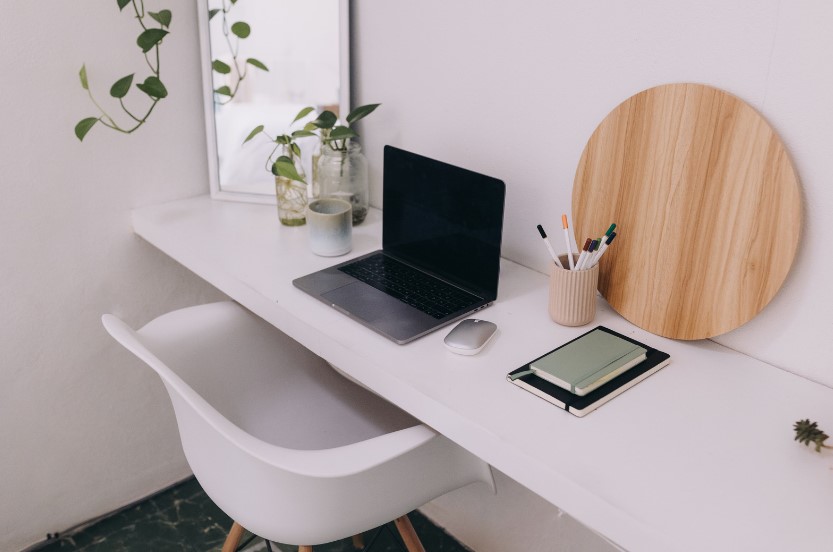
Living with roommates, in a tiny studio, or stuck with a dorm room? Life on an entry-level salary doesn’t always come with a spare home office. Finding the ideal workspace can be tricky when you’re trying to juggle job or schoolwork in cramped, shared spaces or in a place that’s anything but quiet. Without a dedicated desk or private room, it can be tough to focus, get organized, and stay productive—especially when you’re just starting out.
The good news? You don’t need a high-rise office or a luxury setup to find a spot that works. With a few creative adjustments, you can turn unexpected places—like a corner of your living room, a cozy coffee shop, or even a park bench—into a productive, inspiring workspace. Here’s how you can transform everyday spaces into your very own office, no matter where you are.
7 Ideas for Finding the Ideal Workspace
As a recent grad or student, carving out a workspace in a small apartment, shared home, or bustling dorm can feel challenging. Whether you’re living with roommates or dealing with limited space, you can still create a focused, inspiring office environment. Here are some innovative ways to set up your workspace—at home, out in the community, and even using a few mobile tricks to keep your productivity on track!
1. Home Hacks for Creating Workspace Magic
- Closet Conversion: If you have an unused or half-empty closet, transform it into a mini office! Add a small desk or floating shelf, some wall-mounted storage, and even a curtain for privacy. When you’re done for the day, close the door and leave work behind.
- Floating Desk by the Window: Mount a floating desk or compact folding table to an empty wall or window nook. Not only will this save floor space, but natural light is a great productivity booster.
- Portable “Work Zone” Cart: Invest in a rolling cart with compartments for all your essentials (laptop, notebooks, pens, chargers). Roll it out when you’re working and tuck it away when you’re done. This is especially useful for shared spaces where you need a quick setup.
- Vertical Inspiration Wall: Use a narrow wall as your productivity hub. Add shelves, a corkboard, and hooks for a standing workspace that keeps everything organized without taking up too much room. Plus, standing while you work can keep your energy up!
- Dual-Purpose Furniture: Look for furniture that doubles as a workspace—think lift-top coffee tables or folding desks that double as wall art. This setup makes it easy to pack away your workspace when it’s not in use.
A few ideas to help you convert your home space into an office space!
2. Library & Community Spaces: Hidden Gems for Peaceful Productivity
- Library Study Rooms: Finding the ideal workspace can be done on any (or no) budget. Libraries are a classic go-to for quiet work time. Many public and college libraries offer private study rooms that you can book ahead of time for uninterrupted concentration.
- Community Centers and Local Coffee Shops: Some community centers have common areas or rentable rooms for a small fee, and coffee shops with stable Wi-Fi are always a great choice. Look for lesser-known spots where you can get a bit more privacy.
- Book a Quiet Room at Student Hubs: Many universities allow alumni or student visitors to book private study or meeting rooms even after graduation. It’s a great way to work in a familiar environment if you’re near campus.
3. Flexible Co-Working Spaces
- Day Passes to Co-Working Offices: Many co-working spaces, like WeWork , offer day passes for students or new grads. It’s a flexible way to enjoy a professional workspace without a long-term commitment, and many spaces have networking events that could expand your connections.
- Hotels with a co-working option: Many hotels offer co-working spaces, giving you access to a professional office setting and creative tools like whiteboards, meeting rooms, and high-speed Wi-Fi. Hilton, for example, offers day-use room with a workstation including ample desk space, a comfortable chair, WiFi, and a selection of tea and coffee.
- Community-Driven Pop-Ups: Occasionally, community groups organize pop-up co-working days or “co-working cafés,” where you can join other freelancers and entrepreneurs in shared spaces for free or a small fee. This can be a refreshing change of pace from working solo.
4. Outdoor & Public Spaces: Fresh Air and Fresh Ideas
- Parks with Wi-Fi: Some parks and outdoor spaces now have public Wi-Fi. Working from a picnic table with a view can make even the most challenging tasks more enjoyable. Bring a portable battery pack to keep your devices charged! If you are in NYC, check out this link from the NYC Department of Parks and Recreation.
- Balcony or Rooftop Desk: If you have access to a balcony or rooftop, consider setting up a small desk or foldable table to create an outdoor workspace. Fresh air, natural light, and a bit of a view can boost creativity and make work feel less confined.
- Botanical Gardens & Public Plazas: Many public botanical gardens or plazas are quiet, serene, and make for excellent work spots. Plus, the greenery is proven to reduce stress and enhance focus.
5. Mobile Office Solutions: Productivity Anywhere
- Backseat Desk Setup: If you have a car, the backseat can double as a quiet workspace. Keep a mobile desk that hooks onto the seat or place a lap desk across the back seats for a simple, private setup.
- Portable Power Stations and Mobile Wi-Fi: A power bank and a mobile Wi-Fi hotspot can transform almost any location into a temporary workspace. Perfect for when you want to work at an off-the-grid spot or in a remote park.
- Noise-Canceling Headphones for Public Spaces: If you’re working in a café or community center, noise-canceling headphones can help you stay focused. Consider pairing them with productivity music or ambient sounds that keep you in the zone.
6. Work from a Friend’s Place or a Co-Working Buddy System
- The “House Swap” Method: Team up with a friend who has a quieter setup for a few hours each week. They can come over to your place one day, and you can go over to theirs on another.
- Co-Working with Roommates: Coordinate “quiet hours” with roommates to share the common areas when one of you needs focused work time. You can even create a designated “quiet corner” in the apartment for anyone needing to study or work.
- Local Business Partnerships: Some businesses—especially during slower hours—welcome freelancers or remote workers to use their space. Ask around to see if there are cafes, bookshops, or boutiques with quiet corners that welcome remote workers!
7. Create a Virtual Work Space for Group Study or Networking
- Virtual Co-Working Spaces: Set up regular virtual co-working sessions with friends, classmates, or mentors on platforms like Zoom or Microsoft Teams. Studies show that working alongside others, even virtually, can improve focus and keep you accountable.
- Find a Remote Mentor or Study Group: Virtual study groups can serve as a great support system for productivity. Organize weekly catch-up meetings with a mentor or friends working remotely, sharing tips, resources, and encouragement.
- Use Virtual Backgrounds and Focus Modes: For video calls, create a virtual office background for a professional look. Some video platforms also have “focus mode” options, which hide all participants but the speaker, helping you avoid distractions.
Finding or creating an office space doesn’t have to mean a permanent desk with a door! With a little creativity, you can set up an inspiring and flexible workspace that suits your lifestyle. Try mixing and matching these options until you find the setup that makes you feel productive, focused, and ready to tackle whatever comes your way.

